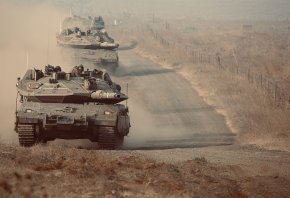Big_Zucchini
Well-Known Member
I'm an Israeli. You like AFVs. Let's make this work.
I'll start with something iconic. A Merkava 4M patrol, showing for the first time some sort of cover for the radar panels. Perhaps ballistic protection, as the cover appears metallic or at least hard, and not a fabric.

Something interesting to note is that from this perspective, closer to the ground and at a distance, the size of the hull and turret, relative to each other, can be observed accurately.
A common saying about the tank, perhaps a misunderstanding, is that the hull is exceedingly large and vulnerable, while in fact it is the 2nd smallest hull in the west in terms of height, only surpassed by the Abrams, whose rather unique protection scheme requires such height restrictions.
The turret, however, is externally the biggest in the west.
First time I was near a Merkava 4, I was surprised at how small its hull is, and how big its turret is. And then when I went inside I was also surprised how small the turret is, and is just inflated in size by armor.
Here's some data I collected via pixel counting, showing relative height only:
T-14 T+H = 60
T-14 T = 23
T-14 H = 37
T-90 T+H = 45
T-90 T = 19
T-90 H = 26
M1A2 T+H = 51
M1A2 T = 22
M1A2 H = 29
Leopard 2A5 T+H = 56
Leopard 2A5 T = 23
Leopard 2A5 H = 33
Leclerc T+H = 53
Leclerc T = 22
Leclerc H = 31
Challenger 2 T+H = 56
Challenger 2 T = 22
Challenger 2 H = 34
Ariete T+H = 54
Ariete T = 21
Ariete H = 33
Merkava 4 T+H = 59
Merkava 4 T = 29
Merkava 4 H = 30
I'll start with something iconic. A Merkava 4M patrol, showing for the first time some sort of cover for the radar panels. Perhaps ballistic protection, as the cover appears metallic or at least hard, and not a fabric.

Something interesting to note is that from this perspective, closer to the ground and at a distance, the size of the hull and turret, relative to each other, can be observed accurately.
A common saying about the tank, perhaps a misunderstanding, is that the hull is exceedingly large and vulnerable, while in fact it is the 2nd smallest hull in the west in terms of height, only surpassed by the Abrams, whose rather unique protection scheme requires such height restrictions.
The turret, however, is externally the biggest in the west.
First time I was near a Merkava 4, I was surprised at how small its hull is, and how big its turret is. And then when I went inside I was also surprised how small the turret is, and is just inflated in size by armor.
Here's some data I collected via pixel counting, showing relative height only:
T-14 T+H = 60
T-14 T = 23
T-14 H = 37
T-90 T+H = 45
T-90 T = 19
T-90 H = 26
M1A2 T+H = 51
M1A2 T = 22
M1A2 H = 29
Leopard 2A5 T+H = 56
Leopard 2A5 T = 23
Leopard 2A5 H = 33
Leclerc T+H = 53
Leclerc T = 22
Leclerc H = 31
Challenger 2 T+H = 56
Challenger 2 T = 22
Challenger 2 H = 34
Ariete T+H = 54
Ariete T = 21
Ariete H = 33
Merkava 4 T+H = 59
Merkava 4 T = 29
Merkava 4 H = 30









